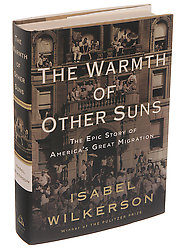|
The Warmth of Other Suns
The Warmth of Other Suns: The Epic Story of America's Great Migration is a 2010 non-fiction book by Pulitzer Prize-winning author Isabel Wilkerson. The book provides a detailed historical account of the Great Migration, a movement of approximately six million African Americans from the Southern United States to the Midwest, Northeast, and West between 1915 and 1970. Wilkerson's work has been widely acclaimed for its comprehensive research, engaging narrative style, and significant contribution to the understanding of this crucial period in American history.[1] Background and researchWilkerson spent 15 years researching and writing The Warmth of Other Suns, conducting over 1,200 interviews and extensively reviewing archival materials.[2] Her approach combined rigorous historical research with a narrative non-fiction style, focusing on the personal stories of three individuals who participated in the Great Migration. This methodology allowed Wilkerson to present a comprehensive view of the migration while maintaining a deeply personal and engaging narrative.[3] SynopsisThe book chronicles the Great Migration through the lives of three primary subjects:
Through these personal narratives, Wilkerson illustrates the broader historical context of the Great Migration, including the social, economic, and political factors that drove millions of African Americans to leave the South.[1] The author explores themes such as racial discrimination, economic opportunity, and the search for personal freedom and dignity.[3] Historical contextWilkerson situates the Great Migration within the larger context of American history, drawing parallels to other significant migration movements and exploring its long-term impact on American society, culture, and politics. The book discusses how the Great Migration transformed both the South and the North, reshaping urban landscapes and challenging existing racial paradigms.[4] Social and economic factorsWilkerson examines the various push and pull factors that influenced the Great Migration, including:
Literary style and approachThe Warmth of Other Suns is notable for its blend of historical analysis and narrative storytelling. Wilkerson's prose has been praised for its clarity and emotional resonance, making complex historical events accessible to a wide readership.[2] The book's structure, alternating between individual stories and broader historical context, allows readers to understand the Great Migration on both personal and societal levels.[3] Use of oral historyWilkerson's extensive use of oral history techniques in her research adds depth and authenticity to the narrative. By incorporating the voices and experiences of those who lived through the Great Migration, the book provides a nuanced and human perspective on this historical phenomenon.[6] Critical receptionThe Warmth of Other Suns received widespread critical acclaim upon its release. It was praised for its comprehensive research, engaging narrative style, and significant contribution to the understanding of African American history and the Great Migration.[1] Awards and honorsThe book has received numerous awards and accolades, including:
In 2024, The Warmth of Other Suns was ranked second on The New York Times' 100 Best Books of the 21st Century, further cementing its status as a seminal work in American literature and historical non-fiction.[10] Scholarly impactThe book has made a significant impact in academic circles, influencing subsequent research on the Great Migration and African American history. Scholars have praised Wilkerson's work for its contribution to the field and its potential to reshape public understanding of this crucial period in American history.[6] Cultural impact and legacyThe Warmth of Other Suns has had a lasting impact on popular understanding of the Great Migration and its significance in American history. The book has been widely adopted in educational settings, from high schools to universities, and has sparked renewed interest in the study of African American migration patterns.[11] It has established itself as a landmark work in the study of the Great Migration and African American history. Through its blend of personal narratives and historical analysis, the book has brought the complexities and significance of this massive demographic shift to a wide audience. Its critical acclaim, scholarly impact, and cultural resonance underscore its importance as a contribution to American literature and historical understanding. Adaptations and related worksThe book's success has led to various adaptations and related projects:
References
Further reading
External links |
||||||||||||||||||||||||
Portal di Ensiklopedia Dunia
